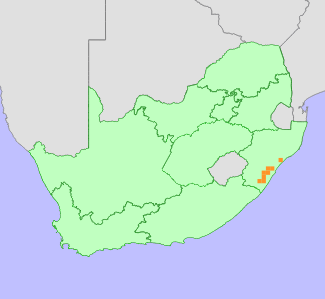|
Scientific Name | Argyrolobium longifolium (Meisn.) Walp. |
Higher Classification | Dicotyledons |
Family | FABACEAE |
Synonyms | Argyrolobium natalense Dummer, Chasmone longifolia Meisn. |
National Status |
Status and Criteria | Endangered A2ce; B1ab(iii,v)+2ab(iii,v) |
Assessment Date | 2021/04/03 |
Assessor(s) | T.J. Edwards, D. Raimondo & L. von Staden |
Justification | A restricted endemic to the coastal grasslands of KwaZulu-Natal Province South Africa, this species has an extent of occurrence of 3928 km² and an area of occupancy (AOO) of at least 100 km². A population reduction of at least 50% is inferred to have taken place over the past three generations based on 57% of this species' habitat having been converted for agroforestry plantations, and urban and agricultural developments over the past 120 years (generation length 50-100 years). The population is severely fragmented and small isolated subpopulations continue to decline as a result of severe degradation due to the spread of invasive alien plants and livestock overgrazing. It qualifies for listing as Endangered under criterion A and B. |
Distribution |
Endemism | South African endemic |
Provincial distribution | KwaZulu-Natal |
Range | This species' distribution extends from Pietermaritzburg to Tugela and Port Shepstone. |
Habitat and Ecology |
Major system | Terrestrial |
Major habitats | KwaZulu-Natal Sandstone Sourveld, Moist Coast Hinterland Grassland, Dry Coast Hinterland Grassland |
Description | It occurs in Ngongoni and sandstone grassland. |
Threats |
| Conversion of sandstone grasslands, predominantly to sugarcane and timber plantations, has resulted in more than 57% loss of habitat over the past 120 years, with the result that only small remnants remain. These are often subjected to severe overgrazing and inappropriate fire management, which leads to poor recruitment. Remaining fragments are also becoming increasingly degraded, particularly due to the spread of unmanaged alien invasive plants, and loss of sandstone grasslands continues, particularly due to infrastructure development and urban expansion. |
Population |
This species is currently known from a number of records from a limited area of sandstone grasslands between Pinetown, Pietermaritzburg and Richmond. Older records, with imprecise locality descriptions indicate that it was possibly more widespread in the past, occurring as far north as Stanger, and as far south as the Ixopo district. Within these areas, grasslands have been extensively irreversibly modified. Known remaining subpopulations are all confined to small, isolated grassland fragments. This species is a long-lived resprouter, and a population reduction of at least 50% is inferred from the 57% extent of habitat loss (calculated in GIS using landcover data) over the past three generations (generation length estimated at least 50 years). Extensive monitoring data collected between 2005 and 2020 indicate that the majority of subpopulations are small consisting of fewer than 10 plants, only one subpopulation of 50- 100 plants has been recorded in the Highflats district. The population is thus severely fragmented and is experiencing ongoing decline as a result of habitat degradation.
|
Population trend | Decreasing |
Assessment History |
Taxon assessed |
Status and Criteria |
Citation/Red List version | | Argyrolobium longifolium (Meisn.) Walp. | VU B1ab(i,iii,v) | Raimondo et al. (2009) | | Argyrolobium longifolium (Meisn.) Walp. | Lower Risk - Least Concern | Scott-Shaw (1999) | |
Bibliography |
Edwards, T.J. 2005. A synopsis of Argyrolobium (tribe Genisteae, Papilionoideae) in South Africa. South African Journal of Botany 71(3):380-417.
Raimondo, D., von Staden, L., Foden, W., Victor, J.E., Helme, N.A., Turner, R.C., Kamundi, D.A. and Manyama, P.A. 2009. Red List of South African Plants. Strelitzia 25. South African National Biodiversity Institute, Pretoria.
Scott-Shaw, C.R. 1999. Rare and threatened plants of KwaZulu-Natal and neighbouring regions. KwaZulu-Natal Nature Conservation Service, Pietermaritzburg.
|
Citation |
| Edwards, T.J., Raimondo, D. & von Staden, L. 2021. Argyrolobium longifolium (Meisn.) Walp. National Assessment: Red List of South African Plants version 2024.1. Accessed on 2025/10/26 |
 Comment on this assessment
Comment on this assessment


